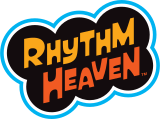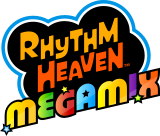Rhythm Tengoku/Arcade: Difference between revisions
No edit summary |
mNo edit summary |
||
| Line 9: | Line 9: | ||
|Mode = 1-2 player(s) | |Mode = 1-2 player(s) | ||
|Input = Control Pad | |Input = Control Pad | ||
|name = Rhythm Tengoku (Arcade) | |||
|name = Rhythm Tengoku (Arcade)|image = [[File:Arcade_Title.png|300px]]|developer = Nintendo SPD<br>JP Room|publisher = [[Nintendo]]<br>[[Sega]]|platform = Arcade|release = {{JP}}July 2007|rating = {{ratings|cero=A}}|mode = Single player, Multiplayer|games = 78 (+ | |image = [[File:Arcade_Title.png|300px]] | ||
|developer = Nintendo SPD<br>JP Room | |||
|publisher = [[Nintendo]]<br>[[Sega]] | |||
|platform = Arcade | |||
|release = {{JP}}July 2007 | |||
|rating = {{ratings|cero=A}} | |||
|mode = Single player, Multiplayer | |||
|games = 78 (53 + Extra + 2P) | |||
|previous = [[Rhythm Tengoku]] | |||
|next = [[Rhythm Heaven]] | |||
|jname = リズム天国 | |||
|rname = Rhythm Tengoku}} | |||
'''Rhythm Tengoku''' is an arcade port of [[Rhythm Tengoku|the video game of the same name]]. It was developed by Nintendo and published by SEGA. It was released on September 20, 2007. | '''Rhythm Tengoku''' is an arcade port of [[Rhythm Tengoku|the video game of the same name]]. It was developed by Nintendo and published by SEGA. It was released on September 20, 2007. | ||
==History== | ==History== | ||
According to an Iwata Asks interview apparently SEGA approached them with an offer for an arcade version as the game was popular with SEGA staff. Osawa and [[Ko Takeuchi]] was impressed because he never thought Rhythm Tengoku was able to gain a following. | According to an Iwata Asks interview apparently SEGA approached them with an offer for an arcade version as the game was popular with SEGA staff. Osawa and [[Ko Takeuchi]] was impressed because he never thought Rhythm Tengoku was able to gain a following. | ||
==List of Rhythm Games== | ==List of Rhythm Games== | ||
All of the [[Rhythm_Tengoku#List of Rhythm Games| | All of the [[Rhythm_Tengoku#List of Rhythm Games|Rhythm Games]] that appeared in the GBA version can also be played in this one directly from the start. The arcade version has an Extra stage of games as well. | ||
{| width="100%" border="1" style="border-collapse:collapse" | {| width="100%" border="1" style="border-collapse:collapse" | ||
|- bgcolor="#fff7f7" | |- bgcolor="#fff7f7" | ||
| Line 95: | Line 106: | ||
|[[File:Air Batter Tempo Up title.png|172px]] | |[[File:Air Batter Tempo Up title.png|172px]] | ||
|} | |} | ||
==Differences== | ==Differences== | ||
*The [[Rhythm Test]], [[Rhythm Shiryo Shitsu]], Studio, [[Café]], [[Rhythm Toys]], [[Endless Games]], [[Drumming Lessons]], Credits, and [[ | *The [[Rhythm Test]], [[Rhythm Shiryo Shitsu]], Studio, [[Café]], [[Rhythm Toys]], [[Endless Games]], [[Drumming Lessons]], Credits, and [[Live]] are all absent from this version. Most of the music unique to them has been repurposed for new features in this version. | ||
** [[ | ** [[Neko Machine]] and [[Kokuhaku Machine]] can be seen in the attract mode instead. The latter can also be interacted with. | ||
** The [[Drum Girls]] make a cameo on the Player Mode menu. | ** The [[Drum Girls]] make a cameo on the Player Mode menu. | ||
*Players start the game with two hearts. Each heart is lost when starting a game. Getting a [[Superb]] or [[Perfect]] gives you an extra heart, as well as close the game for the rest of the Stage. If the player runs out of hearts, they will need to spend a credit to continue. The player needs to clear all five games per stage with at least an [[OK]] in order to play the [[Remix]]. | *Players start the game with two hearts. Each heart is lost when starting a game. Getting a [[Superb]] or [[Perfect]] gives you an extra heart, as well as close the game for the rest of the Stage. If the player runs out of hearts, they will need to spend a credit to continue. The player needs to clear all five games per stage with at least an [[OK]] in order to play the [[Remix]]. | ||
**If the player enters the game's Service Mode, they can change several settings, including the number of hearts they start off with, how many coins need to be inserted for a credit and if the Remix is open or not. | **If the player enters the game's Service Mode, they can change several settings, including the number of hearts they start off with, how many coins need to be inserted for a credit and if the Remix is open or not. | ||
| Line 110: | Line 119: | ||
*The game has a leader board feature, tallying up the score based on the player's flow at the end of a stage. | *The game has a leader board feature, tallying up the score based on the player's flow at the end of a stage. | ||
*The graphics are the same as the original version. However, the resolution is larger, and the game applies a filter to smooth the visuals. Some prologue images are replaced with higher quality versions, as well. | *The graphics are the same as the original version. However, the resolution is larger, and the game applies a filter to smooth the visuals. Some prologue images are replaced with higher quality versions, as well. | ||
==Gallery== | ==Gallery== | ||
<gallery> | <gallery> | ||
| Line 116: | Line 124: | ||
File:Highscore gender arcade.png|If the player has a high enough flow at the end of the Stage, they register it into the leaderboard. First by selecting their gender... | File:Highscore gender arcade.png|If the player has a high enough flow at the end of the Stage, they register it into the leaderboard. First by selecting their gender... | ||
File:Congarts! (Enter your Name).png|Then by entering their name. | File:Congarts! (Enter your Name).png|Then by entering their name. | ||
File:End screen arcade.png|Regardless of whether or not the player gets a high score, they will always see this screen, with the [[ | File:End screen arcade.png|Regardless of whether or not the player gets a high score, they will always see this screen, with the [[Girl]] telling them to try the next stage. | ||
File:start.jpg| After completeing a 2 player stage. | File:start.jpg| After completeing a 2 player stage. | ||
File:Screenshot 12.jpg|During the 2 player compatibility check. | File:Screenshot 12.jpg|During the 2 player compatibility check. | ||
| Line 129: | Line 137: | ||
==External Links== | ==External Links== | ||
*[http://web.archive.org/web/20131216011233/http://rhythm-tengoku.sega.jp/ Rhythm Tengoku (Arcade) Offical Site (Japanese, Internet Archive)] | *[http://web.archive.org/web/20131216011233/http://rhythm-tengoku.sega.jp/ Rhythm Tengoku (Arcade) Offical Site (Japanese, Internet Archive)] | ||
{{RHGames}} | {{RHGames}} | ||
[[Category:Rhythm Tengoku]] | [[Category:Rhythm Tengoku]] | ||
Revision as of 02:57, 7 August 2020
JP Room
| CERO: |
Rhythm Tengoku
Rhythm Heaven
Rhythm Tengoku is an arcade port of the video game of the same name. It was developed by Nintendo and published by SEGA. It was released on September 20, 2007.
History
According to an Iwata Asks interview apparently SEGA approached them with an offer for an arcade version as the game was popular with SEGA staff. Osawa and Ko Takeuchi was impressed because he never thought Rhythm Tengoku was able to gain a following.
List of Rhythm Games
All of the Rhythm Games that appeared in the GBA version can also be played in this one directly from the start. The arcade version has an Extra stage of games as well.
Additionally, this version has a 2P Mode.
Differences
- The Rhythm Test, Rhythm Shiryo Shitsu, Studio, Café, Rhythm Toys, Endless Games, Drumming Lessons, Credits, and Live are all absent from this version. Most of the music unique to them has been repurposed for new features in this version.
- Neko Machine and Kokuhaku Machine can be seen in the attract mode instead. The latter can also be interacted with.
- The Drum Girls make a cameo on the Player Mode menu.
- Players start the game with two hearts. Each heart is lost when starting a game. Getting a Superb or Perfect gives you an extra heart, as well as close the game for the rest of the Stage. If the player runs out of hearts, they will need to spend a credit to continue. The player needs to clear all five games per stage with at least an OK in order to play the Remix.
- If the player enters the game's Service Mode, they can change several settings, including the number of hearts they start off with, how many coins need to be inserted for a credit and if the Remix is open or not.
- The games Spaceball, Iai Giri, Sick Beats, Bunny Hop, Night Walk and Polyrhythm now have tutorials unlike the original. Bouncy Road also has a tutorial in addition to it's practice.
- The player no longer receives a Try Again for getting a question wrong in the practice of Quiz Show. The game simply moves on to the next question instead.
- Ninja Bodyguard uses Left and Right on the D-pad, instead of D-pad and A. The arrows above the ninja are changed accordingly.
- If the player has played perfectly for the first half of a minigame, the "Go for a Perfect!" notice will appear on the bottom of the screen. Obtaining it does the same as getting a Superb however.
- The game has a leader board feature, tallying up the score based on the player's flow at the end of a stage.
- The graphics are the same as the original version. However, the resolution is larger, and the game applies a filter to smooth the visuals. Some prologue images are replaced with higher quality versions, as well.
Gallery
Regardless of whether or not the player gets a high score, they will always see this screen, with the Girl telling them to try the next stage.
Trivia
- This is one of the very few games developed by Nintendo and SEGA.
- This was playable in Hyper Japan 2016 in London.
- This is the first game in the series to have a Two-Player mode.
- Although, the first multiplayer game in the main series would be Rhythm Heaven Fever.
External Links
| Rhythm Heaven Series | |||
|---|---|---|---|

|

|

|

|
| 2006, GBA • 2007, Arcade | 2008-2009, DS | 2011-2012, Wii • 2016, Wii U | 2015-2016, 3DS |







